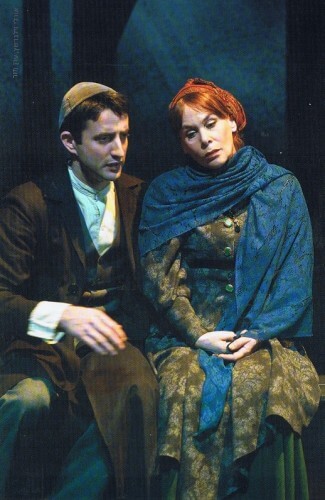In the play, at the Chamber Theater, the director Edna Mazia and the actors recreate the Jewish town, because it should have been, in a free adaptation based on Shalom Aleichem's first story

One of the questions my son asked me on Holocaust Day a few years ago is how people lived in the period before the Holocaust. Surely they had a normal life - work, entertainment, loves, hates?
In other words, did they have a normal life (and for some an abnormal life like many people have even today.
So that's it, except for another language they spoke - Yiddish, they lived a day-to-day life similar to ours in Israel and to a certain extent also parallel. The double barrier - language and the change of time that makes any language obsolete after a while - was successfully overcome by the director Edna Mazia in the play Stampanio based on the novel of this name by Shalom Aleichem.
The plot of the play does indeed deal with one important issue - will forbidden love between two people married to other partners come true, but in the background we get a sense of what life in the town looked like for the professionals in it - the merchants, the wise students, members of the klezmer band, spending Shabbat on the boardwalk, a journey from town To the city by train (still, the 20th century...). Perhaps inspired by the question my son asked, how did the Jews live a normal life before the Holocaust.
In the play, staged at the Chamber Theater, we can see through the Hebrew language of the 21st century how our ancestors thought in a Jewish town somewhere in Eastern Europe. And the problems are not that far away. It turns out that Shalom Aleichem has already noticed the dichotomy between his teachings and his art. The son of one of the merchants was a scholar, and Miza introduces into the dialogues between him and his parents issues of today - should one only study Talmud or also help father in the store?
The discussion of whether to realize Zionism and join the Zionist movement (to immigrate to the Land of Israel) or perhaps leave for America comes up in one of the dialogues.
The story is based on Shalom Aleichem's first novel, but already here we see the main ideas that will occupy Shalom Aleichem, even later, although one thing is missing in the whole picture as it appears in the play. Where are the Gentiles? But despite this lack, the show is fascinating, and shows that there have always been loves and hates, rich and poor and a culture that is far from us but closer than you might think.
I happened to visit Vilnius (on the occasion of the LIFE SCIENCES BALTICS conference), and in one of the alleys, not far from the famous city hall, you see an entrance to a puppet theater, and on the wall - a sign in Lithuanian and Yiddish announcing that the theater of the Vilnius ghetto once stood there. The flourishing of Yiddish culture is a fascinating issue, and even more so the fact that within a few decades its loss also came precisely at the height of its flourishing. I'd rather not elaborate on the plot so that you can get an impression for yourself, but a second bullet for the Holocaust, hearing Yiddish at home (at least so that I wouldn't understand) and stories of experiences from life in the Jewish town, it made me nostalgic. Watching the play was also during the preparations for the trip to Eastern Europe, which also included a visit to my mother's hometown in Belarus, but in order not to cloud your mood due to what I saw there, I will deal with this topic in a separate article.
Stampanio, a play by Edna Mzia based on a story by Shalom Aleichem, directed by: Edna Mzia and Ezekiel Lazarov. Participants: Yehezkel Lazarov, Orli Zilberschatz, Liat Harlev, Edna Balilius, Alon Dahan, Matan Zarchia, Eran Mor, Yuval Segal, Assaf Selhov, Hila Ofer, Oded Tzdok, Rona-Lee Shimon.

6 תגובות
With your permission, I will delete this correspondence, to leave the stage for those who want to comment on this article (literally)
Father, thank you.
A manned Soyuz spacecraft was launched from Kazakhstan yesterday
I occasionally try to re-upload old articles but I noticed that her image does not appear on the home page (this feature does not support backward, you have to do manual actions of image association). I didn't want a white hole to remain and I didn't have time to digest the technical operations, so I took it down from the main page. She is still on the site.
my father
I think it was this article:
http://sciam.co.il/archives/979
Father, where did Michael Shermer's article on pattern recognition go?
I'm sure this morning she was on the site, she even had a lot of comments.